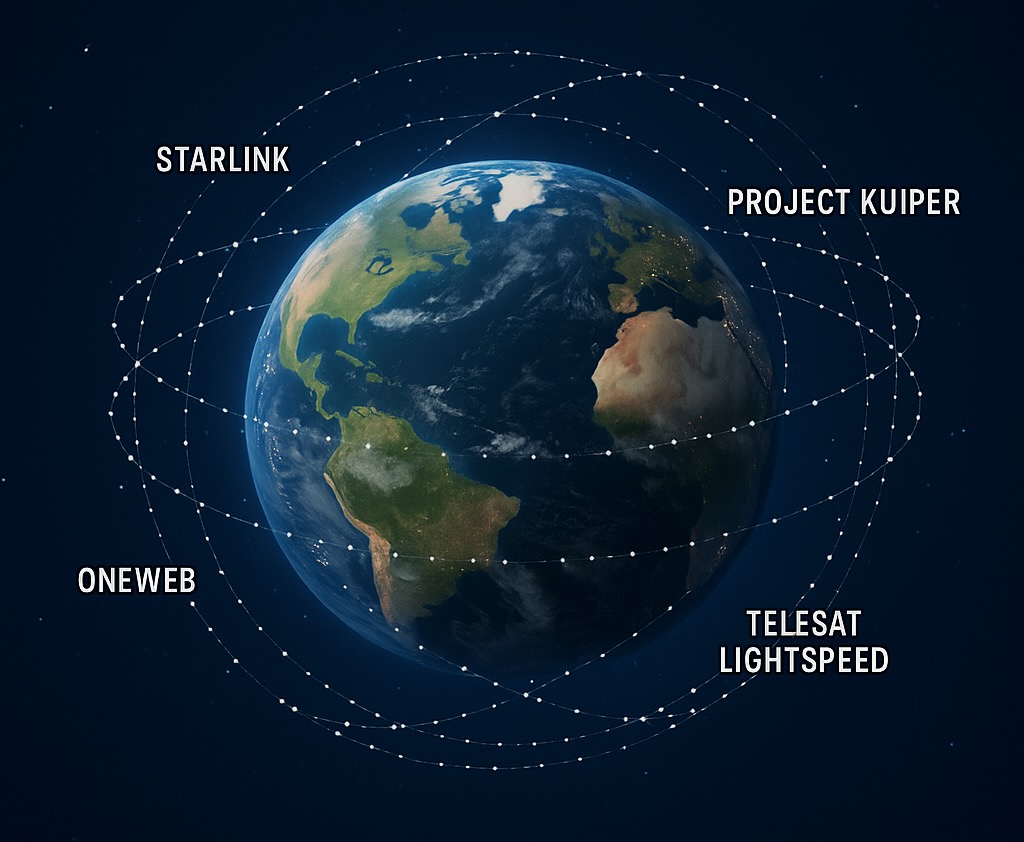In recent years, SpaceX’s Starlink has rapidly become the standard in LEO satellite internet. With its global coverage, high speeds, and low latency, the system has gained popularity in use cases where traditional connections fall short, or are not available at all.
But Starlink is no longer alone. The market for Low Earth Orbit (LEO) satellite connectivity is growing fast, and new players are ready to claim their share of this strategically important space.
New players entering the market
- Amazon’s Project Kuiper – expected to become operational by the end of 2025.
- OneWeb (part of Eutelsat) – with a strong focus on hybrid networks.
- Telesat Lightspeed – targeting enterprise and government sectors.
- Chinese LEO initiatives – state-backed with ambitious deployment plans.
- Iridium – active for many years with a unique service profile.
While Starlink aims for scalable broadband access, these players each focus on specific niches, such as reliability, geographic coverage or integration with existing networks.
Iridium: A quiet force in the satellite landscape
Iridium deserves special mention. While it also operates a LEO constellation, its focus is markedly different:
| Characteristic | Iridium | Starlink / OneWeb |
|---|---|---|
| Focus | Voice, IoT, narrowband | Broadband internet (data/video/etc.) |
| Bandwidth | Low (kbps to a few Mbps) | High (up to 250+ Mbps) |
| Coverage | Global (including the poles) | Global (with expanding reach) |
| Equipment | Compact, mobile, energy-efficient | Large, directional (e.g. Starlink Dish) |
| Typical Use Cases | Emergency communications, IoT, tracking | Construction, maritime, home, mobile WANs |
Iridium is therefore not a broadband satellite alternative, but a complementary solution, ideal for emergency links, narrowband IoT and scenarios where power consumption and reliability matter more than speed.
FWA and Redundancy: Building toward availability
Thanks to Fixed Wireless Access (FWA), increasingly fast and flexible WAN solutions are becoming possible. LEO satellites like Starlink are increasingly used as:
- Backup connections in case of fiber outages.
- Temporary connectivity for construction sites, events, or relocations.
- Redundant WAN links within SD-WAN architectures.
At Wanscale, we believe that no single technology is sufficient on its own. Fiber, 5G, satellite, and LTE are building blocks in a smart, layered architecture. By intelligently combining these technologies, with SD-WAN as the orchestration layer, we create and guarantee 100% connectivity availability, wherever and whenever it’s needed.
No connection is perfect. But by combining multiple imperfect connections, resilience is achieved.
The flip side of the coin
The rapid growth of LEO satellite networks such as Starlink and Project Kuiper raises not only technological questions but also broader concerns about sustainability, space regulations, and societal impact. The increase in space objects heightens the risk of collisions and space debris, while the lifespan and decommissioning of satellites remain barely regulated.
At the same time, discussions arise around digital sovereignty: who controls global connectivity and under what conditions? Without clear international agreements, space usage risks becoming a race without rules.
The questions of tomorrow start today
The societal impact of LEO satellite networks therefore goes beyond connectivity alone.
At Wanscale, we not only focus on technical possibilities but also on the long-term consequences. As architects of modern WAN infrastructures, we aim to contribute to solutions that are sustainable, responsible, and inclusive.
Jos Beckers
Senior Consultant at Wanscale

